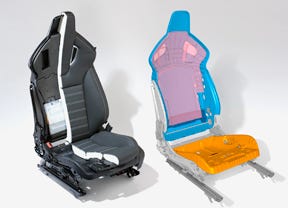Plastics making moves in automotive, airline seating
Recent discussions make clear that engineering thermoplastics potentially could shake up the airline and automotive seating industries, as developments speed ahead in a bid to replace more metal in these high-volume applications.
December 7, 2009
Recent discussions make clear that engineering thermoplastics potentially could shake up the airline and automotive seating industries, as developments speed ahead in a bid to replace more metal in these high-volume applications.
The most vivid example was displayed by plastics supplier BASF at the Fakuma tradeshow last October. The company highlighted the use of a number of its in the new Opel Insignia OPC passenger car, to include in the front seats of the vehicle. Opel worked with Tier One supplier Recaro on the seating.
|
The seats are made of two polyamides belonging to BASF’s Ultramid polyamide (PA) range, as well as of the Neopolen expanded polypropylene (EPP) foam. BASF assisted with its Ultrasim simulation software in the design of the seat pan, backrest shell and crossbar. The plastic parts are replacing the steel frames previously employed. BASF’s work in simulation software extends back more than a decade, and now it even has a website offering extensive information, including case studies, on Ultrasim.
The seat pan is molded of Ultramid B3ZG8, a stiff PA6 that ensures high-energy consumption values. Ultramid B3G10 SI was specified for the freestanding backrest shell as well as in the crossbar. The insert for the backrest shell is made of Neopolen P 9225 K (EPP), energy-absorbing foam that also covers edges and serves as a module carrier for motors and seat components such as the spinal column support.
Prototypes of the seats were shown back in October 2007at the K tradeshow, with the same trio (Opel, Recaro, and BASF) involved.
One company working closely, though not exclusively, with BASF, specifically of late on development of fiber-reinforced polyethersulfone (PES) compounds, is PlastiComp (Winona, MN). PlastiComp has developed from a compounder to become more of a design and manufacturing expert, able to offer its customers FEM (finite element method) analysis, Moldflow filling software, parts design and more, while still also marketing compounds. “We’re not bound to a specific matrix material nor to a particular process,” explains Stan Verbraak, business development manager for PlastiComp Europe GmbH (Steenbergen, The Netherlands).
One of PlastiComp’s customers recently developed airline seating using one of these PES-based compounds in which those parts passed the 16G crash test (other seating components not made of the fiber-reinforced PES did not pass). Airline seating still largely is metal. If some of the airline developments eventually move into automotive seating, “It could be a game changer,” reckons Verbraak.
Verbraak says many of the company’s most recent developments have been with carbon fiber-reinforced compounds. The price of these fibers has dropped as supply has increased, making them a more viable economic option. Also, although glass is still offered in more tow sizes, carbon fiber suppliers are expanding their product range.
Carbon fiber is more difficult to work with than glass or aramid, he notes, as the rovings are more difficult to open and impregnate. Poor carbon fiber wet-out leaves loose fibers that can float in a facility and even short circuit electrical systems. “So you need to get it (the compounding) right,” he notes.
Beyond seating, opportunities could appear in military applications, sports and leisure products and more; replacement of metal EMI (electronic magnetic impulse) shielding also is possible.
At the IAA automotive tradeshow in September, Johnson Controls revealed its new seating concept, the Synergy-Seat, which it hopes to bring to market in 2012, assuming customers are found. The seats, slimmer than standard seating so that rear passengers have about 5cm more legroom, make heavy use of recycled plastics, especially PP. The amount of PUR foam in the seats has been reduced and is based on bio-polyols. MPW sat in it and it was indeed fine, but would need a long trip to pass final judgment on its comfort. The seats weigh up to 30% less than comparable current ones, says JC. —Matt Defosse
About the Author(s)
You May Also Like



